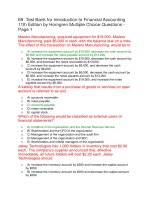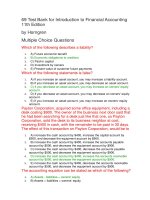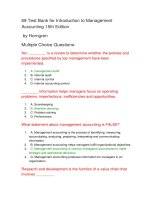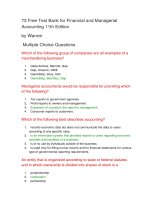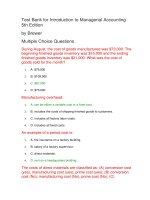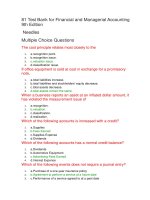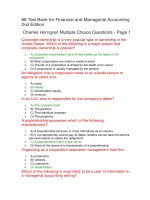Test bank for introduction to managerial accounting 5th edition
Bạn đang xem bản rút gọn của tài liệu. Xem và tải ngay bản đầy đủ của tài liệu tại đây (75.27 KB, 15 trang )
Test Bank for Introduction to Managerial Accounting
5th Edition
by Brewer
Multiple Choice Questions
During August, the cost of goods manufactured was $73,000. The
beginning finished goods inventory was $15,000 and the ending
finished goods inventory was $21,000. What was the cost of
goods sold for the month?
1.
A. $79,000
2.
B. $109,000
3.
C. $67,000
4.
D. $73,000
Manufacturing overhead:
1.
A. can be either a variable cost or a fixed cost.
2.
B. includes the costs of shipping finished goods to customers.
3.
C. includes all factory labor costs.
4.
D. includes all fixed costs.
An example of a period cost is:
1.
A. fire insurance on a factory building.
2.
B. salary of a factory supervisor.
3.
C. direct materials.
4.
D. rent on a headquarters building.
The costs of direct materials are classified as: (A) conversion cost
(yes), manufacturing cost (yes), prime cost (yes); (B) conversion
cost (No), manufacturing cost (No), prime cost (No); (C)
conversion cost (yes), manufacturing cost (yes), prime cost (No);
(D) conversion cost (No), Manufacturing cost (Yes), Prime cost
(yes)
1.
A. A
2.
B. B
3.
C. C
4.
D. D
Each of the following would be classified as variable in terms of
cost behavior except:
1.
A. cost of shipping goods to customers via express mail.
2.
B. sales commissions.
3.
C. plant manager's salary.
4.
D. direct materials.
Transportation costs incurred by a manufacturing company to
ship its product to its customers would be classified as which of
the following?
1.
A. Product cost
2.
B. Manufacturing overhead
3.
C. Period cost
4.
D. Administrative cost
A lawnmower manufacturer computed a cost per unit of $53 by
adding together last month's direct labor, direct materials, and
manufacturing overhead and dividing that total by the 10,000
units produced last month. (There were no beginning or ending
inventories.) If 9,000 units are going to be manufactured this
month, we would expect that the:
1.
A. cost per unit will remain the same.
2.
B. cost per unit will decrease.
3.
C. direction of change in unit costs cannot be determined.
4.
D. cost per unit will increase.
During the month of August, direct labor cost totaled $13,000 and
direct labor cost was 20% of prime cost. If total manufacturing
costs during August were $88,000, the manufacturing overhead
was:
1.
A. $75,000
2.
B. $23,000
3.
C. $65,000
4.
D. $52,000
An opportunity cost is:
1.
A. the difference in total costs which results from selecting one alternative
instead of another.
2.
B. the benefit forgone by selecting one alternative instead of another.
3.
C. a cost which may be saved by not adopting an alternative.
4.
D. a cost which may be shifted to the future with little or no effect on current
operations.
The Lyons Company's cost of goods manufactured was $120,000
when its sales were $360,000 and its gross margin was
$220,000. If the ending inventory of finished goods was $30,000,
the beginning inventory of finished goods must have been:
1.
A. $20,000
2.
B. $50,000
3.
C. $110,000
4.
D. $150,000
Which of the following IS a characteristic of financial accounting?
1.
A. not mandatory
2.
B. must follow GAAP
3.
C. emphasis on relevance of data, rather than precision
4.
D. both A and C above
Managerial accounting:
1.
A. has its primary emphasis on the future.
2.
B. is required by regulatory bodies such as the SEC.
3.
4.
C. focuses on the organization as a whole, rather than on the organization's
segments.
D. Responses a, b, and c are all correct.
Direct materials used in production totaled $330,000. Direct labor
was $415,000 and manufacturing overhead was $220,000. What
were the total manufacturing costs incurred for the month?
1.
A. $530,000
2.
B. $965,000
3.
C. $745,000
4.
D. $635,000
Prime cost consists of direct materials combined with:
1.
A. direct labor.
2.
B. manufacturing overhead.
3.
C. indirect materials.
4.
D. cost of goods manufactured.
Walton Manufacturing Company gathered the following data for
the month: Cost of goods sold: $35,000; Sales: $89,000; selling
expenses: $16,000; Administrative expenses: $21,000. How
much net operating income will be reported for the period?
1.
A. $54,000
2.
B. $17,000
3.
C. $52,000
4.
D. Cannot be determined.
Which two terms below describe the wages paid to security
guards that monitor a factory 24 hours a day?
1.
A. variable cost and direct cost
2.
B. fixed cost and direct cost
3.
C. variable cost and indirect cost
4.
D. fixed cost and indirect cost
Within the relevant range, the difference between variable costs
and fixed costs is:
1.
A. variable costs per unit fluctuate and fixed costs per unit remain constant.
2.
B. variable costs per unit are constant and fixed costs per unit fluctuate.
3.
C. both total variable costs and total fixed costs are constant.
4.
D. both total variable costs and total fixed costs fluctuate.
Haan Inc. is a merchandising company. Last month the
company's cost of goods sold was $66,000. The company's
beginning merchandise inventory was $14,000 and its ending
merchandise inventory was $16,000. What was the total amount
of the company's merchandise purchases for the month?
1.
A. $68,000
2.
B. $96,000
3.
C. $64,000
4.
D. $66,000
Which one of the following costs should NOT be considered an
indirect cost of serving a particular customer at a Dairy Queen
fast food outlet?
1.
A. the cost of the hamburger patty in the burger they ordered.
2.
B. the wages of the employee who takes the customer's order.
3.
C. the cost of heating and lighting the kitchen.
4.
D. the salary of the outlet's manager.
Which terms below correctly describe the cost of the black paint
used to paint the dots on a pair of dice?Variable cost;
Administrative cost: A) Yes, Yes; B)Yes, No; C) No, Yes; D) No;
No respectively.
1.
A. A
2.
B. B
3.
C. C
4.
D. D
Green Company's costs for the month of August were as follows:
direct materials, $27,000; direct labor, $34,000; selling, $14,000;
administrative, $12,000; and manufacturing overhead, $44,000.
The beginning work in process inventory was $16,000 and the
ending work in process inventory was $9,000. What was the cost
of goods manufactured for the month?
1.
A. $105,000
2.
B. $132,000
3.
C. $138,000
4.
D. $112,000
Micro Computer Company has set up a toll-free telephone line for
customer inquiries regarding computer hardware produced by the
company. The cost of this toll-free line would be classified as
which of the following?
1.
A. Product cost
2.
B. Manufacturing overhead
3.
C. Direct labor
4.
D. Period cost
Cost of goods manufactured will usually include:A) only costs
incurred during the current period; B)only direct labor and direct
materials costs; C) some costs incurred during the pirod as well
as cost incurred during the current period; D) some period costs
as well as some product costs.
1.
A. A
2.
B. B
3.
C. C
4.
D. D
The plans of management are expressed formally in:
1.
A. the annual report to shareholders.
2.
B. Form 10-Q submitted to the Securities and Exchange Commission.
3.
C. performance reports.
4.
D. budgets.
In August direct labor was 60% of conversion cost. If the
manufacturing overhead for the month was $54,000 and the
direct materials cost was $34,000, the direct labor cost was:
1.
A. $36,000
2.
B. $22,667
3.
C. $51,000
4.
D. $81,000
The cost of fire insurance for a manufacturing plant is generally
considered to be a:
1.
A. product cost.
2.
B. period cost.
3.
C. variable cost.
4.
D. all of the above.
The following costs were incurred in August: Direct materials:
$20,000; Direct labor: $18,000; Manufacturing overhead $21,000;
Selling expenses: $16,000; Administrative expenses:
$21,000.Prime costs during the month totaled:
1.
A. $39,000
2.
B. $59,000
3.
C. $96,000
4.
D. $38,000
The corporate controller's salary would be considered a(n):
1.
A. manufacturing cost.
2.
B. product cost.
3.
C. administrative cost.
4.
D. selling expense.
The three basic elements of manufacturing cost are direct
materials, direct labor, and:
1.
A. cost of goods manufactured.
2.
B. cost of goods sold.
3.
C. work in process.
4.
D. manufacturing overhead.
Gabrisch Inc. is a merchandising company. Last month the
company's merchandise purchases totaled $90,000. The
company's beginning merchandise inventory was $13,000 and its
ending merchandise inventory was $22,000. What was the
company's cost of goods sold for the month?
1.
A. $90,000
2.
B. $99,000
3.
C. $125,000
4.
D. $81,000
Williams Company's direct labor cost is 25% of its conversion
cost. If the manufacturing overhead for the last period was
$45,000 and the direct materials cost was $25,000, the direct
labor cost was:
1.
A. $15,000
2.
B. $60,000
3.
C. $33,333
4.
D. $20,000
Buford Company rents out a small unused portion of its factory to
another company for $1,000 per month. The rental agreement will
expire next month, and rather than renew the agreement Buford
Company is thinking about using the space itself to store
materials. The term to describe the $1,000 per month is:
1.
A. sunk cost.
2.
B. period cost.
3.
C. opportunity cost.
4.
D. variable cost.
18 Free Test Bank for Accounting What the Numbers
Mean 9th Edition by Marshall Multiple Choice
Questions
Cost accounting is a subset of which of the following?
1.
A. Internal auditing.
2.
B. Public auditing.
3.
C. Cost analysis.
4.
D. Managerial accounting.
Which of the following is qualified to express an auditor's opinion
about an entity's financial statements?
1.
A. A Comptroller.
2.
B. A Certified Management Accountant.
3.
C. A Certified Internal Auditor.
4.
D. A Certified Public Accountant.
5.
E. None of the above.
The ethical concept of integrity means that an individual must:
1.
A. Sign a pledge to abide by all laws and regulations.
2.
B. Report to a supervisor any violation of the code of conduct of her
company that is observed.
3.
C. Read, understand, and agree to follow all provisions of her employer's
code of conduct.
4.
D. Attempt to be honest and forthright in dealings and communications with
others.
The provisions of the Sarbanes-Oxley Act of 2002 had the
following components:
1.
A. Enforce auditing.
2.
B. Attestation.
3.
C. Quality control.
4.
D. None of the above are provisions.
5.
E. A, B and C are correct.
The ethical concept of independence means that an accountant
employed:
1.
A. By a corporation cannot prepare financial statements for use by the
company's bank.
2.
B. By one company cannot work part-time for another company.
3.
C. By an auditing firm cannot own any stock in the company being audited.
4.
D. By one company cannot accept a job with another company in the same
industry.
Major classifications of accounting activity would not include:
1.
A. financial accounting, internal auditing, public accounting.
2.
B. internal auditing, governmental accounting, managerial accounting.
3.
C. financial accounting, national accounting, cost accounting.
4.
D. auditing, income tax accounting, governmental accounting.
The objectives of financial reporting for nonbusiness enterprises:
1.
2.
A. Are exactly the same as those for business enterprises.
B. Focus on providing information for resource providers, rather than
investors.
3.
C. Have more of an internal utilization rather than external reporting focus.
4.
D. Do not give consideration to the cost of providing information.
Which of the following entities would not require accounting
information pertaining to their economic activities?
1.
A. Social clubs.
2.
B. Not-for-profit entities.
3.
C. State governments.
4.
D. All of the above require accounting information.
5.
E. None of the above requires accounting information.
Which of the following is an objective of financial reporting by
business enterprises?
1.
A. Financial reporting should provide assurance that all liabilities of
business enterprises will be paid.
2.
B. Financial reporting should show the timing and amount of future cash
dividends to potential investors.
3.
C. The primary focus of financial reporting is information about the assets of
the entity.
4.
D. Financial reporting should provide information about the economic
resources of an enterprise, the claims to those resources, and changes in
those resources and claims to them.
Which of the following is not a characteristic or limitation of the
kind of information that financial reporting by business enterprises
can provide?
1.
A. The information results in approximate, rather than exact, measures.
2.
B. The information largely reflects the financial effects of transactions that
have already happened.
3.
4.
C. The information is provided and used at a cost.
D. All of the above are characteristics or limitations of the kind of
information that financial reporting by business enterprises can provide.
Which of the following is not an example of a decision or informed
judgment that a potential investor would make from accounting
information?
1.
A. Future profitability based on past profitability.
2.
B. Probability of success of a new product development.
3.
4.
C. A forecast of dividends.
D. Assessment of risk that a company may have more debt than it can
repay if the economy enters a recession.
The officer of a corporation responsible for the firm's published
financialstatements would be most concerned about
pronouncements of the:
1.
A. FASB.
2.
B. AICPA.
3.
C. GASB.
4.
D. SEC.
5.
E. IRS.
Which of the following is not an example of a decision or informed
judgment that a potential employee could make from accounting
information?
1.
A. Personnel turnover statistics (i.e., hiring and terminations).
2.
B. Probability of the company's ability to make profit sharing plan
contributions in the future.
3.
C. Assessment of the risk that the company may become bankrupt in the
near future.
4.
D. The extent of the company's commitment to a research program.
Which of the following is not an objective of financial reporting
described in FASB Concepts Statement No. 1?
1.
2.
3.
4.
A. To provide information about how management of an enterprise has
discharged its stewardship responsibility to owners.
B. To measure the current market value of the business enterprise.
C. To provide information so potential investors or creditors can make their
own predictions of future earnings.
D. To focus primarily on information about earnings and its components.
5.
E. All of the above are objectives of financial reporting.
An unqualified auditors' opinion about an entity's financial
statements:
1.
A. is a clean bill of health.
2.
B. means that all of the entity's transactions during the audited period were
checked out.
3.
C. guarantees that the entity was not involved in or the victim of any
fraudulent activities during the audited period.
4.
D. states that they are presented in conformance with generally accepted
accounting principles.
Which of the following is true about the IASB?
1.
A. Created to promote world acceptance and observation of accounting and
financial reports.
2.
B. The IASB is a private body and the pronouncements cannot be
enforced.
3.
C. Both A and B are correct.
4.
D. None of the above is correct.
Which of the following statements about the Financial Accounting
Standards Board is correct?
1.
A. The FASB is an agency of the Federal government.
2.
B. The FASB has the authority to fine a noncompliant firm.
3.
C. The FASB follows a due process procedure that permits input from
interested parties before a standard is issued.
4.
D. The FASB is controlled by the American Institute of CPA's.
5.
E. None of the above statements is correct.
Which classification of accounting is most concerned with the use
of economic and financial information to plan and control many of
the activities of the entity?
1.
A. Financial accounting.
2.
B. Auditing-Public accounting.
3.
C. Managerial accounting.
4.
D. Income tax accounting.
